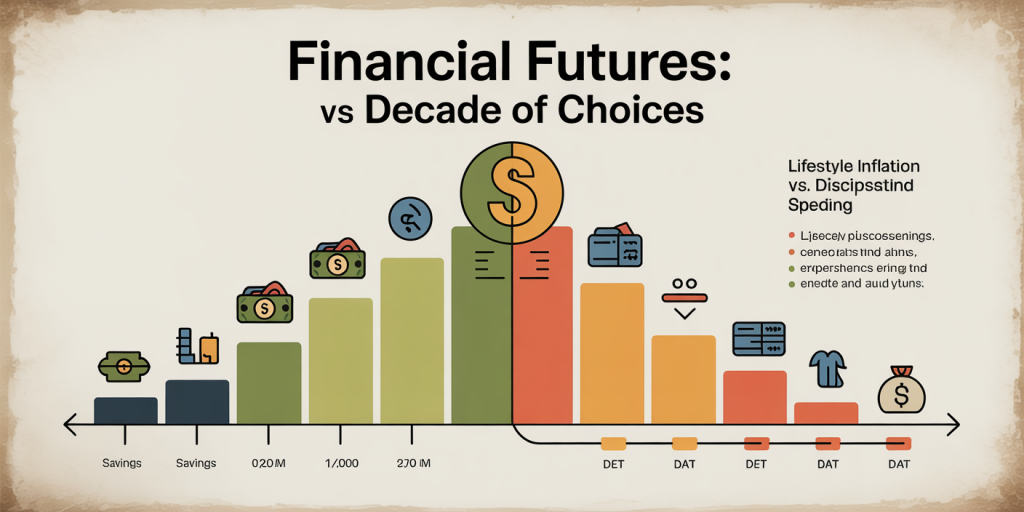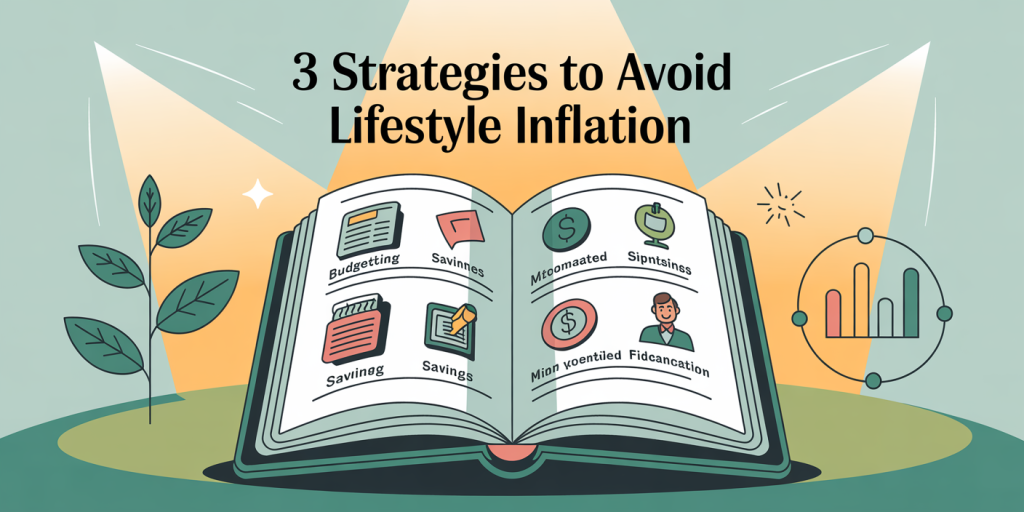Lifestyle Inflation: What It Is and How to Avoid It
Anúncios
In the realm of personal finance, many individuals face a subtle but powerful adversary: lifestyle inflation. At its core, lifestyle inflation refers to the tendency for people to increase their spending as their income rises. While this might appear harmless or even justified, the gradual escalation in expenses can significantly hinder long-term financial stability and wealth accumulation. Understanding lifestyle inflation and learning how to manage or avoid it is essential for anyone striving for financial freedom and security.
Lifestyle inflation is a phenomenon that transcends income brackets and demographics. Studies reveal that nearly 70% of people who receive raises or bonuses tend to increase their spending accordingly, often on non-essential items or services. Over time, this spending growth can lead to living paycheck to paycheck regardless of salary improvements, highlighting the importance of prudent money management.
Anúncios
What Is Lifestyle Inflation?
Lifestyle inflation, often called lifestyle creep, occurs when an individual’s spending increases as their income increases. Instead of maintaining previous spending habits and saving or investing the additional income, people tend to spend it on upgraded living expenses such as fancier cars, larger homes, or frequent dining out.
For example, imagine a professional who receives a 20% salary increase. Instead of saving this extra income, they may upgrade from an economical sedan to a luxury vehicle or move to a pricier apartment. While these upgrades provide immediate gratification, they also drive monthly expenses higher, reducing the financial gains intended from the raise.
This financial behavior can also lead to disproportionate increases in fixed costs, making it harder to manage debt and emergency expenses. According to a 2023 Bankrate survey, nearly 68% of Americans experience lifestyle inflation after achieving a higher income bracket, contributing to the stagnation of their net worth over time.
Symptoms and Signs of Lifestyle Inflation
Recognizing lifestyle inflation early is critical to maintaining financial health and achieving long-term goals. Some common signs include: Increasing fixed monthly expenses: Upgrading housing, car payments, and recurring service subscriptions. Reduced savings rate despite higher income: An individual’s savings rate decreases even though their income increases. Dependence on credit: More reliance on credit cards or loans to finance lifestyle upgrades. Frequent luxury spending: Regular purchases of high-end goods or dining experiences without a budget.

For instance, consider Jane, who earned $50,000 annually and saved 20%. After a promotion increased her salary to $70,000, her saving dropped to 10% as she bought more expensive clothes, upgraded her smartphone, and increased monthly entertainment budgets. Although her income rose by 40%, her financial cushion barely improved because her expenses inflated in tandem.
Consequences of Lifestyle Inflation on Financial Well-being
The primary consequence of lifestyle inflation is the erosion of potential wealth accumulation. When new income is largely absorbed by increased spending, little remains for savings, investing, or emergency funds. This scenario can lead to long-term financial struggles such as: No improvement in net worth: Even with rising income, net assets remain stagnant or grow minimally. Increased vulnerability during economic downturns: Higher fixed expenses reduce financial flexibility when income is disrupted. Delayed retirement: Insufficient savings translate into working longer to achieve retirement goals. Debt accumulation: Bigger lifestyle commitments often lead to the need for borrowing, aggravating financial stress.

Supporting this, a 2022 survey by the National Bureau of Economic Research found that 45% of middle-income households experienced limited net worth growth over a decade due to lifestyle inflation, despite consistent salary increments.
Comparative Table: Impact of Lifestyle Inflation vs. Disciplined Spending Over 10 Years
| Factor | With Lifestyle Inflation | With Disciplined Spending |
|---|---|---|
| Salary Growth Rate (Annual) | 5% | 5% |
| Savings Rate | 5% of income | 20% of income |
| Net Worth Growth (Approximate) | $75,000 | $300,000 |
| Debt Level | Increasing | Controlled or decreasing |
| Emergency Fund | Insufficient | Fully funded |
This comparison underlines the importance of controlling lifestyle inflation to build substantial savings and reduce financial vulnerabilities.
How to Identify and Resist Lifestyle Inflation
Preventing lifestyle inflation requires intentional behavior and regular self-assessment. Start by tracking expenses and categorizing them into essentials and non-essentials. Regular budget reviews, especially after receiving a salary increase, help identify areas where spending may be creeping upwards.
Setting clear financial goals creates a framework for mindful spending. For instance, if the goal is to save for a home down payment or early retirement, unnecessary expenditure becomes easier to resist. Automation also helps: directing a fixed portion of income towards savings and investments before discretionary spending reduces the temptation to upgrade lifestyle immediately.
Behavioral strategies include reframing the emotional relationship with money. Often, lifestyle inflation is driven by the desire for social status or instant gratification. Acknowledging these impulses and practicing delayed gratification can prevent impulsive purchases.
Moreover, surrounding oneself with a supportive community that values financial responsibility can reinforce positive habits. Consider John and Lisa’s case: upon receiving bonuses, instead of upgrading lifestyle, they committed 50% of the bonus to their retirement fund and consciously avoided lifestyle upgrades. Ten years later, their net worth was $120,000 higher than peers who spent bonuses freely.
Practical Tips and Strategies to Avoid Lifestyle Inflation
To combat lifestyle inflation effectively, the following steps can be applied:
1. Maintain a Fixed Savings Percentage
Decide on a savings percentage from your income and adhere to it regardless of salary changes. For instance, saving 20% consistently ensures that rising income translates into increased savings rather than increased spending.
2. Budget for “Fun Money”
Allocate a fixed amount for discretionary spending within your budget. This allows indulgence without derailing long-term financial plans.
3. Mindful Upgrades
When upgrading expenses, apply the “needs vs. wants” test. Ask if the upgrade is necessary or merely an impulsive desire. Waiting 30 days before making large purchases reduces impulse buying.
4. Automate Savings and Investments
Set up automatic transfers to savings or retirement accounts immediately after each paycheck arrives. This “pay yourself first” technique instills discipline and prevents accidental overspending.
5. Minimize Lifestyle-Linked Debt
Avoid taking loans for depreciating assets like cars or luxury gadgets. Consider buying used items or alternatives that meet needs without excessive costs.
To illustrate, consider Sarah who increased her salary from $60,000 to $85,000 but kept her living expenses steady by continuing to live in her current apartment and driving her existing car. She automated 30% of her income to retirement and investment accounts. Six years later, her investment portfolio grew fivefold, whereas many peers who increased spending saw only modest savings growth.
The Role of Mindset and Financial Education
Lifestyle inflation is deeply connected to mindset and financial literacy. Many people experience pressure to “keep up” with peers or societal expectations, which fuels unnecessary spending. Understanding the psychological components behind spending decisions is vital.
Financial education equips individuals with the tools to analyze future consequences, understand compound interest, and prioritize goals effectively. For example, the Average Annual Return (AAR) of the S&P 500 has been approximately 10% over the past century (source: Vanguard). Investing an incremental $500 monthly rather than spending it on lifestyle upgrades can generate over $1 million in 30 years.
Employers and financial advisors increasingly recognize the need to promote financial education to avoid lifestyle inflation among employees benefiting from income growth and bonuses.
Future Perspectives: Navigating Inflation and Changing Economic Dynamics
As global economic conditions evolve, lifestyle inflation presents fresh challenges and opportunities. Rising costs of living, increased availability of credit, and social media influences can pressure consumers toward excessive spending.
Conversely, the rise of financial technology (fintech) brings empowerment through budgeting apps, financial tracking tools, and investment platforms that encourage disciplined money management. Emerging trends such as minimalism and financial independence movements also advocate for reducing lifestyle inflation to enhance freedom and fulfillment.

Future saving behaviors may increasingly depend on personalized financial advice powered by artificial intelligence (AI), enabling tailored strategies to resist lifestyle inflation. Additionally, widespread remote work and gig economies provide varied income sources but also necessitate conscious expenditure planning to avoid transient lifestyles.
In conclusion, lifestyle inflation remains a critical factor that can either impede or propel personal financial growth. By understanding its mechanisms, recognizing early signs, applying strategic controls, and embracing financial education, individuals can achieve sustained financial wellness and leverage income growth effectively. The journey to financial independence demands vigilance, discipline, and a long-term perspective to prevent lifestyle inflation from becoming an obstacle—turning higher income into higher wealth instead of higher expenses.
